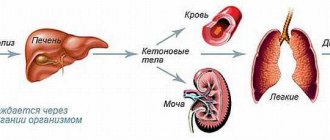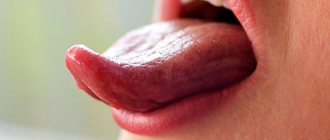Many parents notice with alarm that the child’s tongue is undergoing changes - it suddenly changes its normal color, begins to peel and peel. Why do such changes occur, do they represent a serious pathology, and what treatment is required?
Geographic tongue, which is also known as desquamative glossitis, is a disease of an inflammatory-dystrophic nature, accompanied by external changes in the mucous surface of the tongue. This disease does not have any “age limits” - it can occur with equal frequency in adults and newborns. Most often, geographic tongue is diagnosed completely by accident, at a regular dentist appointment.
Causes of geographic spots on the tongue
Geographic tongue is a disease manifested by dystrophic and inflammatory processes in the mucous membrane of the tongue.
The condition is characterized by alternating areas of peeling and thickening on the surface of the tongue. You should know why a child develops a geographic tongue and what parents need to do in this case. Causes of the disease:
- lack of B vitamins;
- diseases of the gastrointestinal tract (gastritis, gastroduodenitis, malabsorption syndrome, pancreatitis);
- endocrine diseases;
- autoimmune diseases (systemic lupus erythematosus, rheumatoid arthritis, multiple sclerosis);
- severe forms of viral infection;
- exudative diathesis, colds;
- diseases of the oral cavity.
Blood diseases, nervous disorders and autonomic-endocrine disorders are also the causes of geographic spots on the tongue. In children, the disease is often a companion to helminthic infestation. Predisposing factors include heredity and diseases of the spleen.
Causes
Due to the fact that the causes of glossitis have not been identified for certain, it would be more correct to talk about risk groups of patients who are more susceptible to developing this disease. The following can be considered as provoking factors that can cause the onset of the disease:
- Disturbances in the normal functioning of the gastrointestinal tract.
- Diseases of the circulatory system.
- Disorders of the nervous system.
- Hormonal imbalances.
- Weakened immunity.
- Pregnancy.
- Acute infectious diseases.
- Avitaminosis.
- Dysbacteriosis, including those caused by long-term use of antibiotics.
- Heredity.
Desquamative glossitis is a chronic disease. It is absolutely not contagious. In about half of the cases it develops together with a folded tongue and glossalgia.
Symptoms of the disease
Symptoms most often appear on the back and side of the tongue. The disease is characterized by alternating areas of desquamation of the epithelium and thickening of the mucosa, resulting in whitish-gray and bright pink spots. In appearance they resemble a geographical map.
There are no obvious symptoms in this case. The condition is usually diagnosed when a patient is examined for another pathology. In rare cases (especially when eating spicy, hot and salty foods), the patient may complain of:
- change in tongue sensitivity;
- burning and tingling sensation;
- itching;
- discomfort while eating.
On our website Dobrobut.com you can make an appointment with a doctor and get answers to all your questions. If necessary, the specialist will prescribe additional diagnostics and a course of treatment after receiving the examination results.
Symptoms of geographic tongue
The main symptoms of desquamative glossitis are visible to the naked eye, so most often diagnosing the disease does not cause any particular difficulties. In the vast majority of cases, geographic tongue refers to painless pathologies - the disease is not accompanied by any complaints or painful sensations.
The appearance of the geographic tongue exactly corresponds to its name - whitish stripes, grooves and spots appear on the mucous surface of the tongue, which visually resemble a geographical map. The sizes of such spots can be very different - from several millimeters to centimeters. Most often, such lesions are multiple, and in extremely rare cases - single.
At the initial stages of the disease, the spots are small in size, but quickly begin to grow, merging with each other and creating larger spots.
The appearance of a geographic tongue in some cases may be accompanied by a feeling of discomfort, itching and tingling on the surface of the tongue, especially these unpleasant sensations intensify during meals. When eating too hot or cold, sour, spicy or salty foods, a person may experience disturbances in the sensitivity of the tongue, up to a complete loss of taste.
Diagnosis and treatment of geographic tongue in an adult
Diagnosis of the disease in most cases does not cause difficulties. The diagnosis is made after a thorough examination and history. In some cases, consultation with a dentist and gastroenterologist will be required.
When making a diagnosis in adults, an extensive examination is necessary. When collecting anamnesis, the presence of chronic diseases and allergic manifestations, as well as the state of the immune system, is taken into account. Taking all this into account, the doctor will prescribe a course of treatment for geographic tongue in an adult and monitor its implementation.
Folk remedies
For the treatment of geographic tongue, traditional medicine has a large number of recipes that relieve burning and other unpleasant symptoms, and also help accelerate regenerative processes.
- Twice a day you need to rinse your mouth with a solution prepared from a glass of warm water, half a teaspoon of soda and a few drops of iodine. It is necessary to continue such procedures until the clinical manifestations of the disease completely disappear.
- A mixture of equal amounts of nettle, crushed oak bark and mint is infused in a thermos in a liter of hot water. The resulting warm infusion is used to rinse the mouth after each meal.
- Vegetable oil (natural olive, unrefined sunflower or any other) is sterilized in a bottle in a water bath for 30 minutes. After it cools down, rinse your mouth for 2-3 minutes. The procedure must be repeated regularly twice a day until the symptoms of the disease disappear.
- Prepare a decoction of sage (1 tablespoon of herb per 200 ml of water) and rinse the mouth with it before and after meals until complete healing.
Sometimes parents practice treating geographic language with spells. But such methods are questionable and most likely the effect of their use is explained by the spontaneous cure of the disease.
Although geographic tongue is not a serious illness, its symptoms cannot be neglected. If even the slightest signs of the disease appear, it is necessary to visit a doctor in order to identify its causes and prescribe the optimal treatment option.
Treatment of pathology
Drug therapy is aimed at eliminating the underlying cause. Geographic tongue is not an independent disease, but a condition that signals serious problems in the body.
Additional events:
- sanitation of the oral cavity;
- exclusion of salty, spicy and hot foods from the diet;
- alkaline rinses, local applications with anesthetic;
- prescription of antihistamines;
- prescription of multivitamin complexes.
If you strictly follow the doctor’s recommendations, the prognosis for the disease is favorable.
Traditional medicine recommends using oak bark decoction, calendula or chamomile decoction as rinses. You can also use propolis (applied to the affected areas), vegetable oil (oral baths) and honey.
4.Treatment
In cases of asymptomatic disease, if there are no signs of underlying somatic diseases, therapy is not required and is not prescribed. The exception is the mandatory sanitation of problematic teeth and oral cavity, as well as normalization of the diet - which, however, is indicated for absolutely all people.
If there are symptoms of a particular disease that may be the cause or basis for the development of desquamative glossitis, the patient is referred to a specialist of the appropriate profile, where he receives etiopathogenetic treatment.
Complications and prevention
Geographic tongue is not an independent disease, but its appearance signals serious disturbances in the functioning of the body. The sooner you contact a specialist, the sooner adequate treatment will be prescribed. Timely therapy is a guarantee of a high-quality cure for the disease.
In childhood, complications are very rare.
Preventive actions. Fighting bad habits, taking vitamins in the spring and autumn, adequate treatment of gastrointestinal diseases and timely sanitation of the oral cavity will help avoid this condition.
Book a consultation with our specialists and find out how to treat geographic tongue disease.
1.General information
The apt, albeit somewhat frivolous name “geographic tongue” refers to the inflammatory-dystrophic process in the mucous membrane of the tongue, also known as “wandering glossitis”, “migratory oral erythema”, “exfoliative glossitis” (formulation in ICD-10), “desquamative glossitis”, etc. Exfoliative in translation means “flaky”, desquamative means “deprived of scales”, glossitis is inflammation of the tongue. Peeling of the epithelium in combination with inflammation and dystrophic changes together form red and white patterns on the tongue, which in many cases really resemble a fragment of a geographical map.
In different historical periods in medicine, there were different views on the essence and pathogenesis of desquamative glossitis (the term and concept were introduced into the medical paradigm in 1831), and the discussion continues to this day. Thus, some authors consider this process to be neurodegenerative, others to be purely inflammatory, and others generally consider it as a non-pathological variant of the norm.
The prevalence of “geographic language” varies significantly depending on the age, gender, and clinical composition of the studied samples; in terms of the general population, it is estimated at 2-5% of the population. There is a slight predominance of women, children and adolescents.
A must read! Help with treatment and hospitalization!
Associated symptoms and what they indicate
Diagnosis of the disease is carried out taking into account the accompanying symptoms.
- Small sores on the tongue and lips may indicate a viral infection - herpes
Temperature indicates an inflammatory process. This is typical for candidiasis, herpes, allergies, and aphthous stomatitis.
- Ulcers located under the tongue appear due to injury, candidiasis, and somatic diseases.
- On the tip of the tongue, sores most often form due to mechanical damage to tissue.
- Accompanied by plaque ulcers due to candidiasis and problems with the gastrointestinal tract.
- Small sores on the tongue and lips may indicate a viral infection - herpes. Thrush ulcers often spread to the lips.
- On the tongue and throat, ulcers are formed as a result of mechanical trauma, malocclusion, dehydration, vitamin deficiency, and the use of medications with a high concentration of active substances.
- Ulcers in a baby indicate possible problems with the internal systems of the body. May indicate an allergic reaction, vitamin deficiency, mechanical damage to the tongue, fungal or viral infection.
Possible causes of ulcers on a child’s tongue
Ulcers on the tongue are a symptomatic manifestation characteristic of several diseases. It makes no sense to treat a symptom without eliminating the provoking factor.
Therefore, the primary task is to determine the cause, which is achieved by analyzing a set of signs:
| Causes of ulcers on the tongue | ||
| Name | Description | Associated symptoms |
| Aphthous stomatitis | The disease is characterized by the formation of ulcers on the tongue with a diameter of 1 to 5 mm. The wounds hurt a lot, which is why the child becomes restless and irritable. When there is mechanical impact on the aphthae, they begin to bleed. | Initially, redness appears on the tongue; if left untreated, it turns into gray or white ulcers. Due to the burning and pain from aphthae, eating is difficult. There is also a spreading white coating on the surface of the tongue. |
| Herpes stomatitis | Herpes stomatitis is contagious, caused by the Herpes virus. Many ulcers appear in the child's mouth, which is similar to a rash. The formed bubbles quickly burst, leaving wounds in their place. The lesion is often transferred to the skin of the face, lips and nose. | Blisters on the tongue contain a clear or slightly yellowish liquid. After a breakthrough, painful gray-white ulcers with a narrow scarlet rim are formed. There is also an increased body temperature and an increase in the size of the lymph nodes. |
| Thrush (candidiasis) | The causative agent of the disease is Candida fungi, transmitted through toys, dishes and other household items. The disease can also develop under the influence of infections, hormonal fluctuations (adolescence), and also as a result of hypothermia. | In the absence of treatment, in addition to yellowish and white ulcers, the following are observed: swelling, dry mouth, tightness of the mucous membrane, increased body temperature, cracks in the corners of the mouth. The sores emit an unpleasant odor due to suppuration. |
| Allergy | Formations on the tongue are caused by the body's reaction to an allergen. | The disease manifests itself in the form of red spots and ulcers with blurred outlines. Over time they merge. Other symptoms are: swelling of the lip, face. |
| Gastrointestinal problems | The tongue reflects any problems in the body. If there are problems with the gastrointestinal tract, white ulcers form. | In addition to ulcers on the white tongue, there are: disturbances in the microflora of the oral cavity, discomfort when chewing food and swallowing. The outbreaks are located in small clusters. |
| Tongue injuries | Injury to the tongue or mucous membrane occurs frequently. Ulcers appear in the area of tissue damage. | The ulcers are usually painless and are recognized by their pink or reddish color. If the wounds become infected, yellowish pus may form. Apart from pain at the site of injury, no other symptoms are noted. |







